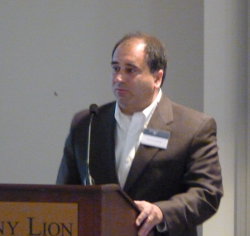2014 OEA: David Francischelli

David Francischelli is this year’s recipient of the Outstanding Engineering Alumni Award for Biomedical Engineering. This award recognizes his impressive professional achievements and is the highest honor for engineering alumni at Penn State. Mr. Francischelli graduated from Saint Michael’s College with a BA in Biology, followed by a MS in bioengineering from Penn State. He went on to obtain an MBA from the University of Saint Thomas. As a testament to Mr. Francischelli’s hard work and innovation, he has authored more than 30 peer-reviewed articles and book chapters and currently holds over 50 U.S. patents. Mr. Francischelli joined AtriCure in 2013 as the Vice President of Research & Development. Earlier, he had a long tenure with Medtronic, Inc., most recently serving as the Director of Research & Development in the Structural Heart Division.
I recently had the opportunity to talk with Mr. Francischelli about his current work, motivations, and views on the field of biomedical engineering:
Q: As a graduate of Penn State, what aspects of the Bioengineering graduate program did you find most helpful in your career?
A: I found that, while I may not have remembered all of the information I learned in my courses, basic concepts have often led me in the right direction in my career. Equally important was that at Penn State, I learned how to apply basic principles to solving real-world problems. I particularly remember referencing textbooks like signal processing for knowledge on the projects I have worked on. Graduate school helped me develop a passion for research on artificial hearts and led me to pursue work with Medtronic.
Q: What are some of the most significant challenges you have faced in your career working in cardiovascular R&D?
A: When working on the left ventricular assist device, I found working with very sick patients was both a challenge and a motivation. It presented a great opportunity to dramatically impact a patient’s quality of life. Later, my work shifted to stroke prevention. I found that while most technical challenges can eventually be solved, a difficult issue is getting tangible results in a limited timeframe. It’s important to coordinate the efforts of diverse groups of people, ranging from engineering to finance to marketing.
Q: What advice would you give to researchers hoping to develop a successful product or device?
A: Successful products come from a larger amount of unsuccessful products. It’s particularly helpful to look at what didn’t work, and why it didn’t work. It’s easy to mark these attempts as failures, but they contain important information in the process of successful product development.
Q: What research is at the forefront of atrial fibrillation technology? How will these advances impact patient health?
A: Currently, goals in atrial fibrillation are to reduce costs, require less invasive procedures, and cut down on procedure time. Patients are particularly interested in less “big hole” procedures, emphasizing less invasive procedures not only reduce morbidity, but also lend to better patient quality of life. I also think interconnectedness of diseases is an active area of research. Additionally, the treatment of sleep apnea is a promising avenue to pursue in the future.
- Erin Richards, Ph.D. bioengineering candidate

